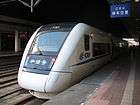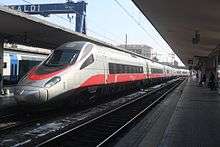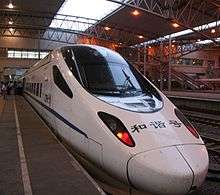High-speed rail in China


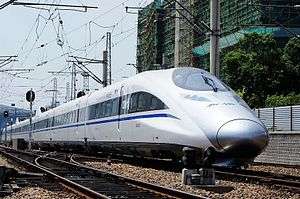

| High-speed rail in China | |||||||
| Simplified Chinese | 中国高速铁路 | ||||||
|---|---|---|---|---|---|---|---|
| Traditional Chinese | 中國高速鐵路 | ||||||
| |||||||
High-speed rail (HSR) in China is a longest HSR system in the world with as of September 2016 over 20,000 km (12,000 mi) of route in service as newly built PDL railways with design speed with 250 km/h (155 mph), and initial operational speed of above 200 km/h (124 mph) with CRH trains as defined by Chinese government.,[1] and general definition is any railway with commercial train service at the top speed of 200 km/h (124 mph) or higher, the nationwide HSR system currently extends to 28 of the country's 33 provinces and regions, provincial-level entity without HSR with top speed of 200 km/h (124 mph) train service is included Yunnan (Dec. 2016), Hong Kong (2018), and Ningxia (2020) with sections under construction; even while there are no plans in the near future for high-speed rail in Tibet and Macau, consisting mainly of newly built passenger-dedicated lines (PDLs) and intercity lines along with upgraded mixed passenger and freight lines.[2]
China has the world's longest network that is part of the network of PDLs alone, a length that is more than the rest of the world's high-speed rail tracks combined.[3] The expansion of the PDL network and other high speed lines is ongoing and will reach a planned 38,000 km (24,000 mi) of PDL routes alone in 2025.[3]
High-speed rail service in China was introduced on April 18, 2007 and has become immensely popular with an annual ridership of over 1.1 billion in 2015, making the Chinese HSR network the most heavily used in the world.[4] Notable lines include the world's longest line, the 2,298 km (1,428 mi) Beijing–Guangzhou High-Speed Railway and the Shanghai Maglev, the world's first high-speed commercial magnetic levitation (maglev) line and the only non-conventional track line of the network.[5]
Nearly all high-speed rail lines and rolling stock are owned and operated by the China Railway Corporation, the state enterprise formerly known as the Railway Ministry, which has overseen the HSR building boom with generous funding from the Chinese government's economic stimulus program. The pace of high-speed rail expansion slowed for a period in 2011 after the removal of Chinese Railways Minister Liu Zhijun for corruption and a fatal high-speed railway accident near Wenzhou, but has since rebounded. Though the system as a whole is considered successful, concerns about HSR safety, high ticket prices, low ridership, financial sustainability and environmental impact of high-speed rail continue to exist for several projects.[6]
China's early high-speed trains were imported or built under technology transfer agreements with foreign train-makers including Alstom, Siemens, Bombardier and Kawasaki Heavy Industries. Chinese engineers then re-designed internal train components and built indigenous trains. Today, most of China's high speed rail trains are thus made in China by the CRRC.
History
.jpg)
Precursor
The earliest example of higher-speed commercial train service in China was the Asia Express, a luxury passenger train that operated in Japanese-controlled Manchuria from 1934 to 1943.[7] The steam-powered train, which ran on the Southern Manchuria Railway from Dalian to Xinjing (Changchun), had a top commercial speed of 110 km/h (68 mph) and test speed of 130 km/h (81 mph).[7] It was faster than the fastest trains in Japan at the time. After the founding of the People's Republic of China in 1949, this train model was renamed the SL-7 and was used by the Chinese Minister of Railways.
Early planning
State planning for China's current high-speed railway network began in the early 1990s. In December 1990, the Ministry of Railways (MOR) submitted a proposal to build a high-speed railway between Beijing and Shanghai to the National People's Congress.[8] At the time, the Beijing–Shanghai Railway was already at capacity, and the proposal was jointly studied by the Science & Technology Commission, State Planning Commission, State Economic & Trade Commission, and the MOR.[8] In December 1994, the State Council commissioned a feasibility study for the line.[8]
Policy planners debated the necessity and economic viability of high-speed rail service. Supporters argued that high-speed rail would boost future economic growth. Opponents noted that high-speed rail in other countries were expensive and mostly unprofitable. Overcrowding on existing rail lines, they said, could be solved by expanding capacity through higher speed and frequency of service. In 1995, Premier Li Peng announced that preparatory work on the Beijing Shanghai HSR would begin in the 9th Five Year Plan (1996–2000), but construction was not scheduled until the first decade of the 21st century.
The "Speed Up" campaigns

.jpg)
In 1993, commercial train service in China averaged only 48 km/h (30 mph) and was steadily losing market share to airline and highway travel on the country's expanding network of expressways.[9][10] The MOR focused modernization efforts on increasing the service speed and capacity on existing lines through double-tracking, electrification, improvements in grade (through tunnels and bridges), reductions in turn curvature, and installation of continuous welded rail. Through five rounds of "Speed-Up" campaigns in April 1997, October 1998, October 2000, November 2001, and April 2004, passenger service on 7,700 km (4,800 mi) of existing tracks was upgraded to reach sub-high speeds of 160 km/h (100 mph).[11]
A notable example is the Guangzhou-Shenzhen Railway, which in December 1994 became the first line in China to offer sub-high-speed service of 160 km/h (99 mph) using domestically produced DF-class diesel locomotives. The line was electrified in 1998, and Swedish-made X 2000 trains increased service speed to 200 km/h (124 mph). After the completion of a third track in 2000 and a fourth in 2007, the line became the first in China to run high-speed passenger and freight service on separate tracks.
The completion of the sixth round of the "Speed-Up" Campaign in April 2007 brought HSR service to more existing lines: 423 km (263 mi) capable of 250 km/h (155 mph) train service and 3,002 km (1,865 mi) capable of 200 km/h (124 mph).[12][N 1] In all, travel speed increased on 22,000 km (14,000 mi), or one-fifth, of the national rail network, and the average speed of passenger trains improved to 70 km/h (43 mph). The introduction of more non-stop service between large cities also helped to reduce travel time. The non-stop express train from Beijing to Fuzhou shortened travel time from 33.5 to less than 20 hours.[15] In addition to track and scheduling improvements, the MOR also deployed faster CRH series trains. During the Sixth Railway Speed Up Campaign, 52 CRH trainsets (CRH1, CRH2 and CRH5) entered into operation. The new trains reduced travel time between Beijing and Shanghai by two hours to just under 10 hours.
The conventional rail v. maglev debate
The development of the HSR network in China was initially delayed by a debate over the type of track technology to be used. In June 1998, at a State Council meeting with the Chinese Academies of Sciences and Engineering, Premier Zhu Rongji asked whether the high-speed railway between Beijing and Shanghai still being planned could use maglev technology.[16] At the time, planners were divided between using high-speed trains with wheels that run on conventional standard gauge tracks or magnetic levitation trains that run on special maglev tracks for a new national high-speed rail network.
Maglev received a big boost in 2000 when the Shanghai Municipal Government agreed to purchase a turnkey TransRapid train system from Germany for the 30.5 km (19.0 mi) rail link connecting Shanghai Pudong International Airport and the city. In 2004, the Shanghai Maglev Train became the world's first commercially operated high-speed maglev. It remains the fastest commercial train in the world with peak speeds of 431 km/h (268 mph) and makes the 30.5 km (19.0 mi) trip in less than 7.5 minutes.

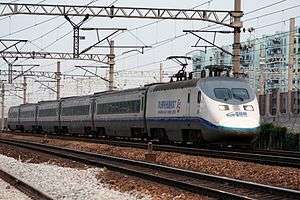


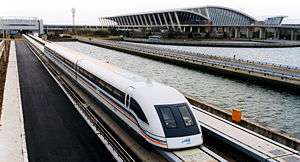
Despite unmatched advantage in speed, the maglev has not gained widespread use in China's high-speed rail network due to high cost, German refusal to share technology and concerns about safety. The price tag of the Shanghai Maglev was believed to be $1.3 billion and was partially financed by the German government. The refusal of the Transrapid Consortium to share technology and source production in China made large-scale maglev production much more costly than high-speed train technology for conventional lines. Finally, residents living along the proposed maglev route have raised health concerns about noise and electromagnetic radiation emitted by the trains, despite an environmental assessment by the Shanghai Academy of Environmental Sciences saying the line was safe.[17] These concerns have prevented the construction of the proposed extension of the maglev to Hangzhou. Even the more modest plan to extend the maglev to Shanghai's other airport, Hongqiao, has stalled. Instead, a conventional subway line was built to connect the two airports, and a conventional high-speed rail line was built between Shanghai and Hangzhou.
While maglev was drawing attention to Shanghai, conventional track HSR technology was being tested on the newly completed Qinhuangdao-Shenyang Passenger Railway. This 405 km (252 mi) standard gauge, dual-track, electrified line was built between 1999 and 2003. In June 2002, a domestically made DJF2 train set a record of 292.8 km/h (181.9 mph) on the track. The China Star (DJJ2) train followed the same September with a new record of 321 km/h (199 mph). The line supports commercial train service at speeds of 200–250 km/h (120–160 mph), and has become a segment of the rail corridor between Beijing and Northeast China. The Qinhuangdao-Shenyang Line showed the greater compatibility of HSR on conventional track with the rest of China's standard gauge rail network.
In 2004, the State Council in its Mid-to-Long Term Railway Development Plan, adopted conventional track HSR technology over maglev for the Beijing–Shanghai High Speed Railway and three other north-south high-speed rail lines. This decision ended the debate and cleared the way for rapid construction of standard gauge, passenger dedicated HSR lines in China.[18][19]
Acquisition of foreign technology
Despite setting speed records on test tracks, the DJJ2, DJF2 and other domestically produced high-speed trains were insufficiently reliable for commercial operation.[20] The State Council turned to advanced technology abroad but made clear in directives that China's HSR expansion cannot only benefit foreign economies.[20] China's expansion must also be used to develop its own high-speed train building capacity through technology transfers. The State Council, MOR and state-owned train builders, the China North Car (CNR) and China South Car (CSR) used China's large market and competition among foreign train-makers to induce technology transfers.
In 2003, the MOR was believed to favor Japan's Shinkansen technology, especially the 700 series.[20] The Japanese government touted the 40-year track record of the Shinkansen and offered favorable financing. A Japanese report envisioned a winner-take all scenario in which the winning technology provider would supply China's trains for over 8,000 km (5,000 mi) of high-speed rail.[21] However, Chinese citizens angry with Japan's World War II atrocities organized a web campaign to oppose the awarding of HSR contracts to Japanese companies. The protests gathered over a million signatures and politicized the issue.[22] The MOR delayed the decision, broadened the bidding and adopted a diversified approach to adopting foreign high-speed train technology.
In June 2004, the MOR solicited bids to make 200 high-speed train sets that can run 200 km/h (124 mph).[20] Alstom of France, Siemens of Germany, Bombardier Transportation based in Germany and a Japanese consortium led by Kawasaki all submitted bids. With the exception of Siemens which refused to lower its demand of RMB(¥) 350 million per train set and €390 million for the technology transfer, the other three were all awarded portions of the contract.[20] All had to adapt their HSR train-sets to China's own common standard and assemble units through local joint ventures (JV) or cooperate with Chinese manufacturers. Bombardier, through its joint venture with CSR's Sifang Locomotive and Rolling Stock Co (CSR Sifang), Bombardier Sifang (Qingdao) Transportation Ltd (BST). won an order for 40 eight-car train sets based on Bombardier's Regina design.[23] These trains, designated CRH1A, were delivered in 2006. Kawasaki won an order for 60 train sets based on its E2 Series Shinkansen for ¥9.3 billion.[24] Of the 60 train sets, three were directly delivered from Nagoya, Japan, six were kits assembled at CSR Sifang Locomotive & Rolling Stock, and the remaining 51 were made in China using transferred technology with domestic and imported parts.[25] They are known as CRH2A. Alstom also won an order for 60 train sets based on the New Pendolino developed by Alstom-Ferroviaria in Italy. The order had a similar delivery structure with three shipped directly from Savigliano along with six kits assembled by CNR's Changchun Railway Vehicles, and the rest locally made with transferred technology and some imported parts.[26] Trains with Alstom technology carry the CRH5 designation.
The following year, Siemens reshuffled its bidding team, lowered prices, joined the bidding for 350 km/h (217 mph) trains and won a 60-train set order.[20] It supplied the technology for the CRH3C, based on the ICE3 (class 403) design, to CNR's Tangshan Railway Vehicle Co. Ltd. The transferred technology includes assembly, body, bogie, traction current transforming, traction transformers, traction motors, traction control, brake systems, and train control networks.
Technology transfer
Achieving indigenous high-speed rail technology has been a major goal of Chinese state planners. Chinese train-makers, after receiving transferred foreign technology, have been able to achieve a considerable degree of self-sufficiency in making the next generation of high-speed trains by developing indigenous capability to produce key parts and improving upon foreign designs.
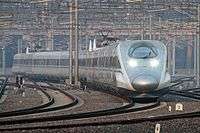
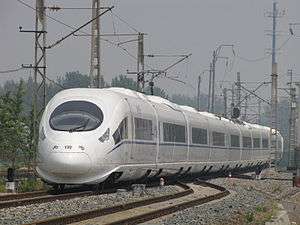
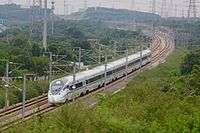
Examples of technology transfer include Mitsubishi Electric’s MT205 traction motor and ATM9 transformer to CSR Zhuzhou Electric, Hitachi’s YJ92A traction motor and Alstom’s YJ87A Traction motor to CNR Yongji Electric, Siemens’ TSG series pantograph to Zhuzhou Gofront Electric. Most of the components of the CRH trains manufactured by Chinese companies were from local suppliers, with only a few parts imported.
For foreign train-makers, technology transfer is an important part of gaining market access in China. Bombardier, the first foreign train-maker to form a joint venture in China, has been sharing technology for the manufacture of railway passenger cars and rolling stock since 1998. Zhang Jianwei, President and Chief Country Representative of Bombardier China, stated that in a 2009 interview, “Whatever technology Bombardier has, whatever the China market needs, there is no need to ask. Bombardier transfers advanced and mature technology to China, which we do not treat as an experimental market.”[27] Unlike other series which have imported prototypes, all CRH1 trains have been assembled at Bombardier’s joint-venture with CSR, Bombardier Sifang in Qingdao.
Kawasaki’s cooperation with CSR did not last as long. Within two years of cooperation with Kawasaki to produce 60 CRH2A sets, CSR began in 2008 to build CRH2B, CRH2C and CRH2E models at its Sifang plant independently without assistance from Kawasaki.[28] According to CSR president Zhang Chenghong, CSR "made the bold move of forming a systemic development platform for high-speed locomotives and further upgrading its design and manufacturing technology. Later, we began to independently develop high-speed CRH trains with a maximum velocity of 300–350 kilometers per hour, which eventually rolled off the production line in December 2007."[29] Since then, CSR has ended its cooperation with Kawasaki.[30] Kawasaki challenged China's high-speed rail project for patent theft, but backed off the effort.[31]
Between June and September 2005, the MOR launched bidding for high-speed trains with a top speed of 350 km/h (217 mph), as most of the main high-speed rail lines were designed for top speeds of 350 km/h or higher. Along with CRH3C, produced by Siemens and CNR Tangshan, CSR Sifang bid 60 sets of CRH2C.
In 2007, travel time from Beijing to Shanghai was about 10 hours at a top speed of 200 km/h (124 mph) on the upgraded Beijing–Shanghai Railway. To increase transport capacity, the MOR ordered 70 16-car trainsets from CSR Sifang and BST, including 10 sets of CRH1B and 20 sets of CRH2B seating trains, 20 sets of CRH1E and 20 sets of CRH2E sleeper trains.
Construction of the high-speed railway between Beijing and Shanghai, the world's first high-speed rail with a designed speed of 380 km/h (236 mph), began on April 18, 2008. In the same year, the Ministry of Science and the MOR agreed to a joint action plan for the indigenous innovation of high-speed trains in China. The MOR then launched the CRH1-350 (Bombardier and BST, designated as CRH380D/DL), CRH2-350 (CSR, designated as CRH380A/AL), and CRH3-350 (CNR and Siemens, designated as CRH380B/BL & CRH380CL), to develop a new generation of CRH trains with a top operation speed of 380 km/h. A total of 400 new generation trains were ordered. The CRH380A, the first indigenous high-speed train of the CRH series, entered service on the Shanghai-Hangzhou High-Speed Railway on October 26, 2010.[32]
On October 19, 2010, the MOR announced the beginning of research and development of "super-speed" railway technology, which would increase the maximum speed of trains to over 500 km/h (311 mph).[33]
Early dedicated high-speed rail lines
After committing to conventional-track high-speed rail in 2006, the state embarked on an ambitious campaign to build passenger-dedicated high-speed rail lines, which accounted for a large part of the government's growing budget for rail construction. Total investment in new rail lines grew from $14 billion in 2004 to $22.7 and $26.2 billion in 2006 and 2007.[34] In response to the global economic recession, the government accelerated the pace of HSR expansion to stimulate economic growth. Total investments in new rail lines including HSR reached $49.4 billion in 2008 and $88 billion in 2009.[34] In all, the state planned to spend $300 billion to build a 25,000 km (16,000 mi) HSR network by 2020.[35][36]

As of 2007, the Qinhuangdao-Shenyang High-Speed Railway, which carried trains at top speed of 250 km/h (155 mph) along the Liaoxi Corridor in the Northeast, was the only passenger-dedicated HSR line (PDL) in China, but that would soon change as the country embarked on a high-speed railway construction boom.
National high-speed rail grid (4+4)
Higher-speed express train service allowed more trains to share the tracks and improved rail transport capacity. But high-speed trains often have to share tracks with slower, heavy freight trains—in some cases with as little as 5 minutes headway.[15] To attain higher speeds and transport capacity, planners began to propose a passenger-dedicated HSR network on a grand scale. Initiated by MOR's 2008 "Mid-to-Long Term Railway Network Plan", a national grid composed of eight high-speed rail corridors, four running north-south and four going east-west, was to be constructed. The envisioned network, together with upgraded existing lines, would total 12,000 km (7,456 mi) in length. Most of the new lines follow the routes of existing trunk lines and are designated for passenger travel only. They became known as passenger-designated lines (PDLs). Several sections of the national grid, especially along the southeast coastal corridor, were built to link cities that had no previous rail connections. Those sections will carry a mix of passenger and freight. High-speed trains on PDLs can generally reach 300–350 km/h (190–220 mph). On mixed-use HSR lines, passenger train service can attain peak speeds of 200–250 km/h (120–160 mph). The earliest PDLs built were sections of the corridors that connected large cities in the same region. On April 19, 2008, Hefei–Nanjing PDL in the East opened with a top-speed of 250 km/h (155 mph). On August 1, 2008, the Beijing–Tianjin Intercity Railway opened in time for the 2008 Summer Olympics. This line between northern China’s two largest cities, was the first in the country to accommodate commercial trains with top speed of 350 km/h (217 mph) and featured the CRH2C and CRH3C train sets. This ambitious national grid project was planned to be built by 2020, but the government's stimulus has expedited time-tables considerably for many of the lines.
The Wuhan–Guangzhou High-Speed Railway (Wuguang PDL), which opened on December 26, 2009, was the country’s first cross-regional high-speed rail line. With a total length of 968 km (601 mi) and capacity to accommodate trains traveling at 350 km/h (217 mph), the Wuguang PDL set a world record for the fastest commercial train service with average trip speed of 312.5 km/h (194.2 mph). Train travel between central and southern China’s largest cities, Wuhan and Guangzhou, was reduced to just over three hours. On October 26, 2010, China opened its 15th high-speed rail, the Shanghai–Hangzhou line, and unveiled the CRH380A trainset manufactured by CSR Sifang started regular service. The Beijing–Shanghai High-Speed Railway, the second major cross-regional line, opened on June 2011 and was the first line designed with a top speed of 380 km/h (236 mph) in commercial service.[37][38]
By January 2011, China had the world’s longest high-speed rail network with about 8,358 km (5,193 mi)[39] of routes capable for at least 200 km/h (124 mph) running in service including 2,197 km (1,365 mi) of rail lines with top speeds of 350 km/h (217 mph).[40] The MOR reportedly committed investment of ¥709.1 billion (US$107.9 billion) in railway construction in 2010 and would invest ¥700 billion (US$106 billion) in 2011 on 70 railway projects, including 15 high-speed rail projects. Some 4,715 kilometres (2,930 mi) of new high-speed railways would be opened, and by the end of 2011, China would have 13,073 kilometres (8,123 mi) of railways capable of carrying trains at speeds of at least 200 km/h (124 mph).[41]
Corruption and concerns
In February 2011, Railway Minister Liu Zhijun, a key proponent of HSR expansion in China, was removed from office on charges of corruption. The Economist estimates Liu accepted ¥1 billion of bribes ($152 million) in connection with railway construction projects.[42] Investigators found evidence that another ¥187 million ($28.5 million) was misappropriated from the $33 billion Beijing–Shanghai High-Speed Railway in 2010.[43] Another top official in the Railways Ministry, Zhang Shuguang, was also sacked for corruption.[42] Zhang was estimated to have misappropriated to his personal overseas accounts the equivalent of $2.8 billion.[44]
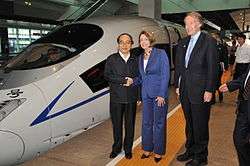
After the political shake-up, concerns about HSR safety, high ticket prices, financial sustainability and environmental impact received greater scrutiny in the Chinese press.[6][45]
In April 2011, the new Minister of Railways Sheng Guangzu said that due to corruption, safety may have been compromised on some construction projects and completion dates may have to be pushed back.[42] Sheng announced that all trains in the high-speed rail network would operate at a maximum speed of 300 km/h (186 mph) beginning on July 1, 2011.[6][46][47] This was in response to concerns over safety, low ridership due to high ticket prices,[48] and high energy usage.[45] On June 13, 2011, the MOR clarified in a press conference that the speed reduction was not due to safety concerns but to offer more affordable tickets for trains at 250 km/h (155 mph) and increase ridership. Higher-speed train travel uses greater energy and imposes more wear on expensive machinery. Railway officials lowered the top speed of trains on most lines that were running at 350 km/h (217 mph) to 300 km/h (186 mph). Trains on the Beijing-Tianjin high-speed line and a few other inter-city lines remained at 350 km/h.[49] In May 2011, China's Environmental Protection Ministry ordered the halting of construction and operation of two high-speed lines that failed to pass environmental impact tests.[50][51] In June, the MOR maintained that high-speed rail construction was not slowing down.[52] The CRH380A trainsets on the Beijing–Shanghai High-Speed Railway could reach a top operational speed of 380 km/h (240 mph) but were limited to 300 km/h.[37][53] Under political and public pressure, the National Audit Office (NAO) carried out an extensive investigation into the building quality of all high-speed rail lines. As of March 2011, no major quality defects had been found in the system.[54] Foreign manufacturers involved in Shanghai-Beijing high-speed link reported that their contracts call for maximum operational speed of 300 km/h (186 mph).[55] From July 20, 2011, the frequency of train service from Jinan to Beijing and Tianjin was reduced due to low occupancy, which renewed concerns about demand and profitability for high-speed services.[56] Service failures in the first month of operation drove passengers back to pre-existing slower rail service and air travel; airline ticket prices rebounded due to reduced competition.
Wenzhou accident
On July 23, 2011, two high-speed trains collided on the Ningbo–Taizhou–Wenzhou Railway in Lucheng District of Wenzhou, Zhejiang Province.[57][58][59] The accident occurred when one train traveling near Wenzhou was struck by lightning, lost power and stalled. Signals malfunctioned, causing another train to rear-end the stalled train.[58][60][61][62][63] Several carriages derailed.[64] State-run Chinese media confirmed 40 deaths, and at least 192 people hospitalised, including 12 who were severely injured.[65][66][67] The Wenzhou train accident and the lack of accountability by railway officials caused a public uproar and heightened concerns about the safety and management of China's high-speed rail system.[68][69] Quality and safety concerns also affected plans to export cheaper high-speed train technology to other countries.[70]
Following the deadly crash, the Chinese government suspended new railway project approvals and launched safety checks on existing equipment.[71][72] A commission was formed to investigate the accident with a directive to report its findings in September 2011.[73] On August 10, 2011, the Chinese government announced that it was suspending approvals of any new high-speed rail lines pending the outcome of the investigation.[74][75] The Minister of Railways announced further cuts in the speed of Chinese high-speed trains, with the speed of the second-tier 'D' trains reduced from 250 km/h (155 mph) to 200 km/h (124 mph).[76] The speed of the remaining 350 km/h (217 mph) trains between Shanghai and Hangzhou was reduced to 300 km/h (186 mph) as of August 28, 2011.[77] To stimulate ridership, on August 16, 2011 ticket prices on high-speed trains were reduced by five percent.[78] From July to September, high-speed rail ridership in China fell by nearly 30 million to 151 million trips.[79]
Slowdown in financing and construction
In the first half of 2011, the MOR as a whole made a profit of ¥4.29 billion and carried a total debt burden of ¥2.09 trillion, equal to about 5% of China’s GDP.[80][81] Earnings from the more profitable freight lines helped to off-set losses by high-speed rail lines. As of years ending 2008, 2009 and 2010, the MOR's debt-to-asset ratio was respectively, 46.81%, 53.06% and 57.44%,[82] and reached 58.58% by mid-year 2011.[83] As of October 12, 2011, the MOR had issued ¥160 billion of debt for the year.[81] But in the late summer, state banks began to cut back on lending to rail construction projects, which reduced funding for existing railway projects. An investigation of 23 railway construction companies in August 2011 revealed that 70% of existing projects had been slowed or halted mainly due to shortage of funding.[83] Affected lines included Xiamen-Shenzhen, Nanning-Guangzhou, Guiyang-Guangzhou, Shijazhuang-Wuhan, Tianjin-Baoding and Shanghai-Kunming high-speed rail lines.[79][80] By October, work had halted on the construction of 10,000 km (6,200 mi) of track.[79] New projects were put on hold and completion dates for existing projects, including the Tianjin-Baoding, Harbin-Jiamusi, Zhengzhou-Xuzhou and Hainan Ring (West), were pushed back.[83] As of October 2011, the MOR was reportedly concentrating remaining resources on fewer high-speed rail lines and shifting emphasis to more economically viable coal transporting heavy rail.[81]
To ease the credit shortage facing rail construction, the Ministry of Finance announced tax cuts to interest earned on rail construction financing bonds and the State Council ordered state banks to renew lending to rail projects.[79] In late October and November 2011, the MOR raised RMB 250 billion in fresh financing and construction resumed on several lines including the Tianjin-Baoding, Xiamen-Shenzhen and Shanghai-Kunming.[84]
Another project postponed or cancelled altogether was the proposed Chongqing-Xi'an High-Speed Railway, which was announced in September 2012. This line has been eliminated and travel between the two cities can be achieved by the Lanzhou–Chongqing and Xi'an-Chengdu lines, which will cross at Guangyuan in north-eastern Sichuan.[85]
Recovery
By early 2012, the Chinese government renewed investments in high-speed rail to rejuvenate the slowing economy.[88] Premier Wen Jiabao visited train manufacturers and gave a vote of confidence in the industry.[88] Over the course of the year, the MOR’s budget rose from $64.3 billion to $96.5 billion.[88] Five new lines totaling 2,563 km (1,593 mi) in length entered operation between June 30 and December 31, including the Beijing-Wuhan section of the Beijing-Guangzhou line.[89] By the end of 2012, the total length of high-speed rail tracks had reached 9,300 km (5,800 mi), and ridership had exceeded levels prior to the Wenzhou crash.[90][91] China's 1,580 high-speed trains were transporting 1.33 million passengers daily, about 25.7% of the overall passenger traffic.[89] The Beijing–Tianjin, Shanghai–Nanjing, Beijing–Shanghai and Shanghai–Hangzhou lines reported breaking even financially[92][93][94][95] The Shanghai-Nanjing line even reported to be operationally profitable,[94] operating with a 380 million yuan net profit.[93][94] However the system as a whole is still losing money and concerns about corruption, safety and high ticket prices persist.[95]
On December 28, 2013, the total length of high-speed rail tracks nationally topped 10,000 km (6,200 mi) with the opening of the Xiamen–Shenzhen, Xian–Baoji, Chongqing−Lichuan high-speed railways as well as intercity lines in Hubei and Guangxi.[96]
Second boom
.jpg)
In 2014, high-speed rail expansion gained speed with the opening of the Taiyuan–Xi'an, Hangzhou–Changsha, Lanzhou-Ürümqi, Guiyang-Guangzhou, Nanning-Guangzhou trunk lines and intercity lines around Wuhan, Chengdu,[97] Qingdao[98] and Zhengzhou.[98] High-speed passenger rail service expanded to 28 provinces and regions.[99] The number of high-speed train sets in operation grew from 1,277 pairs in June to 1,556.5 pairs in December.[99][100]
In response to a slowing economy, central planners approved a slew of new lines including Shangqiu-Hefei-Hangzhou,[101] Zhengzhou-Wanzhou,[102] Lianyungang-Zhenjiang,[103] Linyi-Qufu,[104] Harbin-Mudanjiang,[105] Yinchuan-Xi'an,[101] Datong-Zhangjiakou,[101] and intercity lines in Zhejiang[106] and Jiangxi.[101]
The government actively promoted the export of high-speed rail technology to countries including Mexico, Thailand, the United Kingdom, India, Russia and Turkey. To better compete with foreign trainmakers, the central authorities arranged for the merger of the country's two main high-speed train-makers, CSR and CNR, into the China Railway Rolling Stock Group.[107]
By 2015, six high speed rail lines, Beijing–Tianjin, Shanghai–Nanjing, Beijing–Shanghai, Shanghai–Hangzhou, Nanjing–Hangzhou and Guangzhou–Shenzhen–Hong Kong report operational profitability.[108] The Beijing–Shanghai is particularly profitable reporting a 6.6 billion yuan net profit.[109]
In 2016, with the near completion of the National 4+4 grid, a new "Mid-to-Long Term Railway Network" Plan was drafted. The plan envisions a larger 8+8 high speed rail grid serving the nation and expanded intercity lines for regional and commuter services for large metropolitan areas of China.[110] The proposed completion date for the network is 2030.[111]
Current HSR expansion
China's high-speed rail expansion is entirely managed, planned and financed by the government.

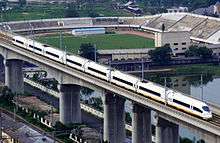
New designs of bullet trains
In November 2016, CRRC Changchun unveiled the first bullet train carriages in the world that would have sleeper berths. Made in the CRRC factory in Changchun and nicknamed Panda, they are capable of running at 250 kmph, operate at -40 degrees Celsius, have wifi hubs and contain sleeper berths that fold into seats during the day.[112]
Policy justifications
Critics both in China and abroad have questioned the necessity of having an expensive high-speed rail system in a largely developing country, where most workers cannot afford to pay a premium for faster travel.[35][36] The government has justified the expensive undertaking as promoting a number of policy objectives. HSR provides fast, reliable and comfortable means of transporting large numbers of travelers in a densely populated country over long distances,[113] which:
- Improves economic productivity and competitiveness over the long term by increasing the transport capacity of railways and linking labor markets.[36][114] Moving passengers to high-speed lines frees up older railways to carry more freight, which is more profitable for railways than passengers, whose fares are subsidized.[113]
- Stimulates the economy in the short term as HSR construction creates jobs and drives up demand for construction, steel and cement industries during the economic downturn. Work on the Beijing–Shanghai HSR mobilized 110,000 workers.[34][114][115]
- Facilitates cross-city economic integration and promotes the growth of second-tier cities. The introduction of the high-speed railways is responsible for 59% of the increase in market potential for the secondary cities connected by bullet trains. (Market potential, a concept used by economic geographers, measures "a geographic area's access to markets for inputs and outputs.") A 10% increase in a secondary city's market potential is expected to be associated with a 4.5% increase in its average real estate price.[116]
- Supports energy independence and environmental sustainability. Electric trains use less energy to transport people and goods on a per unit basis and can draw power from more diverse sources of energy including renewables than automobile and aircraft, which are more reliant on imported petroleum.[113]
- Develop an indigenous high-speed rail equipment industry. The expansion into HSR is also developing China into a leading source of high-speed rail building technology.[34] Chinese train-makers have absorbed imported technologies quickly, localized production processes, and even begun to compete with foreign suppliers in the export market. Six years after receiving Kawasaki's license to produce Shinkansen E2, CSC Sifang can produce the CRH2A without Japanese input, and Kawasaki has ended cooperation with Sifang on high-speed rail.[117]
HSR construction financing
China's high-speed rail construction projects are highly capital intensive. About 40-50% of financing is provided by the national government through lending by state owned banks and financial institutions, another 40% by the bonds issued by the Ministry of Railway (MOR) and the remaining 10-20% by provincial and local governments.[83][113] The MOR, through its financing arm, the China Rail Investment Corp, issued an estimated ¥1 trillion (US$150 billion in 2010 dollars) in debt to finance HSR construction from 2006 to 2010,[118] including ¥310 billion in the first 10 months of 2010.[119] CRIC has also raised some capital through equity offerings; in the spring of 2010, CRIC sold a 4.5 percent stake in the Beijing–Shanghai High-Speed Railway to the Bank of China for ¥6.6 billion and a 4.537 percent stake to the public for ¥6 billion.[118] CRIC retained 56.2 percent ownership on that line. As of 2010, the CRIC-bonds are considered to be relatively safe investments because they are backed by assets (the railways) and implicitly by the government.
| Table:Construction cost of HSR lines in operation. | ||||||||||||||||||||||||||||||||||||||||||||||||||||||||||||||||||||||||||||||||||||||||||||||||||||||||||||||||||
|---|---|---|---|---|---|---|---|---|---|---|---|---|---|---|---|---|---|---|---|---|---|---|---|---|---|---|---|---|---|---|---|---|---|---|---|---|---|---|---|---|---|---|---|---|---|---|---|---|---|---|---|---|---|---|---|---|---|---|---|---|---|---|---|---|---|---|---|---|---|---|---|---|---|---|---|---|---|---|---|---|---|---|---|---|---|---|---|---|---|---|---|---|---|---|---|---|---|---|---|---|---|---|---|---|---|---|---|---|---|---|---|---|---|---|
|

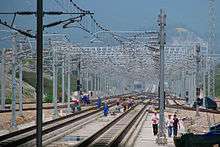
Large construction debt-loads require significant revenues from rider fares, subsidies, and/or other sources of income, such as advertising, to repay. Despite impressive ridership figures, virtually every completed line has incurred losses in its first years of operation. For example, the Beijing–Tianjin Intercity Railway in its two full years of operation, delivered over 41 million rides. The line cost ¥20.42 billion to build, and ¥1.8 billion per annum to operate, including ¥0.6 billion in interest payments on its ¥10 billion of loan obligations.[138] The terms of the loans range from 5–10 years at interest rates of 6.3 to 6.8 percent.[138] In its first year of operation from August 1, 2008 to July 31, 2009, the line carried 18.7 million riders and generated ¥1.1 billion in revenues, which resulted in a loss of ¥0.7 billion. In the second year, ridership rose to 22.3 million and revenues improved to ¥1.4 billion, which narrowed losses somewhat to below ¥0.5 billion.[138] To break even, the line must deliver 30 million rides annually.[138] To be able to repay principal, ridership would need to exceed 40 million.[138] In September 2010, daily ridership averaged 69,000 or an annual rate of 25.2 million.[138] In 2013, ridership totaled 25.85 million.[139] The line has a capacity of delivering 100 million rides annually[140] and initial estimated repayment period of 16 years.[138]
The Shijiazhuang-Taiyuan PDL lost ¥0.8 billion in its first year and is set to lose ¥0.9 billion in 2010.[118] The Southeast HSR corridor lost ¥0.377 billion in its first year beginning August 2009.[118] The Zhengzhou-Xian PDL since opening in February 2010 was expected to generate revenues of ¥0.6 billion in its first full year but must make interest payments of ¥1.1 billion. In the first three quarters of 2012, the line lost Y1.87 billion.[141] The losses must be covered by the operator, which is usually subsidized by local governments.[140] In December 2014, the Henan provincial government imposed a rule requiring municipal authorities pay 70% of the deficit incurred by Henan's intercity lines with the provincial authorities paying the remainder 30%.[142]
The MOR faces a debt-repayment peak in 2014.[118] Some economists recommend further subsidies to lower fares and boost ridership and ultimately revenues.[140] Others warn that the financing side of the existing construction and operation model is unsustainable.[140] If the rail-backed loans cannot be fully repaid, they may be refinanced or the banks may seize ownership of the railways.[118] To prevent that eventuality, the MOR is trying to improve management of its rapidly growing HSR holdings.[118]
Overall, ridership is growing as the high-speed rail network continues to expand. High-speed rail is also becoming relatively more affordable as fares have remained stable while worker wages have grown sharply over the same period.[143]
Cost comparisons
Currently, China's high-speed rail service costs significantly less than similar systems in developed countries, but is considerably more expensive than conventional rail service. For the 419 km (260 mi) trip from Beijing to Jinan, HSR costs CNY185 (US$30) and takes 1 hour 32 minutes, while a conventional train costs CNY73 (US$12) and takes about 6 hours.[144] By comparison, the Acela train from Washington DC to New York City (one of the most expensive trains in regular service worldwide) covering a slightly shorter distance of 230 mi (370 km) costs US$152–180 (Y930) and takes 2 hour 50 minutes.[145] In comparison, high speed trains in France or Germany cost slightly over ten cents per kilometer and the various Shinkansen services hover above twenty cents per kilometer.[146]
Impact on airlines
The spread of high-speed rail has forced domestic airlines in China to slash airfare and cancel regional flights.[147] The impact of high-speed rail on air travel is most acute for intercity trips under 500 km (310 mi).[147] By the spring of 2011, commercial airline service had been completely halted on previously popular routes such as Wuhan-Nanjing, Wuhan-Nanchang, Xi’an-Zhengzhou and Chengdu-Chongqing.[147] Flights on routes over 1,500 km (930 mi) are generally unaffected.[147] As of October 2013, high-speed rail was carrying twice as many passengers each month as the country’s airlines.[143]
Track network
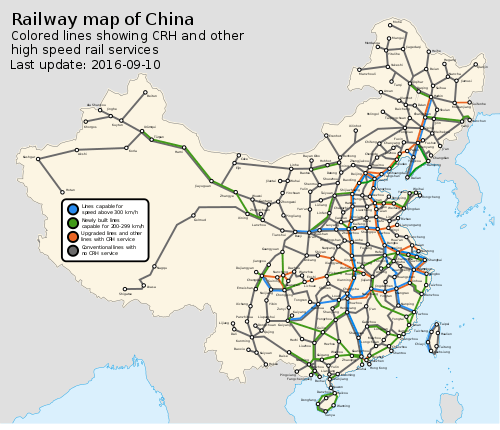
China's high-speed rail system project is ambitious.[115][148] In 2008, the MOR planned to build 25,000 km (16,000 mi) of high-speed railways with trains reaching normal speeds of 350 km/h.[115][149] China invested $50 billion on its high-speed rail system in 2009 and the total construction cost of the high-speed rail system is $300 billion.[115] The main operator of regular high-speed train services is China Railway High-Speed (CRH).

China's conventional high-speed railway network is made up of four components:
- upgraded pre-existing rail lines that can accommodate high-speed trains,
- a national grid of mostly passenger dedicated HSR lines (PDLs),
- other newly built conventional rail lines, mostly in western China, that can carry high-speed passenger and freight trains, and
- certain regional "intercity" HSR lines.
Most of the rail lines now under construction belong to one of the three latter categories.[150]
In 2016, the National Development and Reform Commission (NDRC) planned to build "Eight Vertical and Eight Horizontal" high-speed railway network, which replaced "Four Vertical and Four Horizontal".[151]
Upgraded railways
The centerpiece of the MOR's expansion into high-speed rail is a new national high-speed rail grid that is overlaid onto the existing railway network. Following the sixth round of the "railway speed up campaign" on April 18, 2007, some 6,003 km (3,730 mi) of track could carry trains at speeds of up to 200 km/h (124 mph). Of these, 848 km (527 mi) could attain 250 km/h (155 mph). These include the Qinhuangdao-Shenyang (Qinshen) Passenger Railway, and sections of the Qingdao-Jinan (Jiaoji), Shanghai-Kunming (Hukun) between Hangzhou and Zhuzhou, Guangzhou-Shenzhen (Guangshen), Beijing–Shanghai (Jinghu), Beijing-Harbin (Jingha), Beijing-Guangzhou (Jingguang), Longhai between Zhengzhou to Xuzhou, Railways. Upgrade work continues on other lines including the Wuhan-Danyang (Handan), Hunan-Guizhou (Xianggui), and Nanjing-Nantong (Ningqi) Railways.
Some 295 stations have been built or renovated to allow high-speed trains.[152]
National high-speed rail grid (8+8)
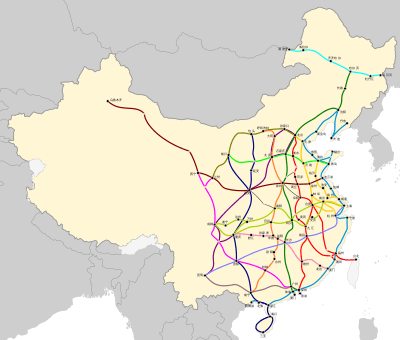
The national "Eight Vertical and Eight Horizontal" high-speed railway network (simplified Chinese: “八纵八横”高速铁路主通道; traditional Chinese: “八縱八橫”高速鐵路主通道; pinyin: “Bā Zòng Bā Héng” Gāosù Tiělù Zhǔ Tōngdào) is a proposed high-speed railway network, that expands on the nearly complete 4+4 network initiated by the 2008 "Mid-to-Long Term Railway Network Plan". The new 2016 plan calls an additional four vertical and four horizontal corridors creating an 8+8 network.[151] The proposed lines include Coastal Passageway, Beijing-Shanghai Passageway, Beijing-Hong Kong (Taipei) Passageway, Beijing-Harbin, Beijing-Hong Kong (Macau) Passageway, Hohhot-Nanning Passageway, Beijing-Kunming Passageway, Baotou (Yinchuan)-Hainan Passageway, Lanzhou (Xining)-Guangzhou Passageway, Suifenhe-Manzhouli Passageway, Beijing-Lanzhou Passageway, Qingdao-Yinchuan Passageway, Europe-Asia Transport Passageway, Yangtze River Passageway, Shanghai-Kunming Passageway, Xiamen-Chongqing Passageway, and Guangzhou-Kunming Passageway.
Service
China Railways, the MOR's national rail service operator, provides high-speed train service called China Railway High-speed (CRH) (中国铁路高速) on upgraded conventional rail lines, national high-speed railways and intercity high-speed lines. The CRH's high-speed trains are also called "Harmony Express." In October 2010, CRH service more than 1,000 trains per day, with a daily ridership of about 925,000.[153] as of May, 2015, a total of 1469 CRH trainsets were put into use.
Ridership
| Ridership | ||
|---|---|---|
| Year | million riders | ±% p.a. |
| 2007 | 61.21 | — |
| 2008 | 127.73 | +108.68% |
| 2009 | 179.58 | +40.59% |
| 2010 | 290.54 | +61.79% |
| 2011 | 440 | +51.44% |
| 2012 | 486 | +10.45% |
| 2013 | 672 | +38.27% |
| 2014 | 893.2 | +32.92% |
| 2015 | 1,161 | +29.98% |
| Source: [89] 2011[154][155] 2015[156] | ||
Annual HSR ridership is highest in the world. China is the third country, after Japan and France, to have one billion cumulative HSR passengers.
CRH service on upgraded conventional lines

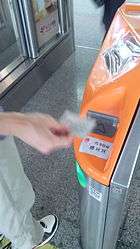

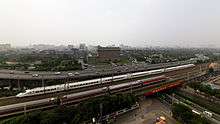
As of September 2010, there were 2,876 kilometres (1,787 mi) of upgraded conventional railways in China that can accommodate trains running speeds of 200 to 250 km/h.[157] Over time with the completion of the national high-speed passenger-dedicated rail network, more CRH service will shift from these lines to the high-speed dedicated lines.
A. Intercity service (typically, listed in schedules as C-series or D-series trains):
- Beijing – Beidaihe, Qinhuangdao
- Beijing – Tianjin, Tanggu
- Beijing – Shijiazhuang, Taiyuan
- Shanghai – Kunshan, Suzhou, Wuxi, Changzhou, Nanjing, Hefei, Xuzhou
- Shanghai – Hangzhou, Yiwu, Jinhua, Quzhou
- Nanjing – Hangzhou
- Guangzhou – Shenzhen
- Wuhan – Zhengzhou, Changsha
- Changsha – Nanchang
- Xi'an – Baoji
B. Long-haul service (typically, listed in schedules as G-series or D-series trains):
- Beijing – Shenyang, Changchun, Harbin
- Beijing – Jinan, Qingdao, Shanghai
- Beijing – Zhengzhou, Wuhan
- Shanghai – Zhengzhou, Qingdao, Shenyang
- Shanghai – Nanchang
- Wuhan – Changsha – Guangzhou
| Table:HSR service on conventional rail lines | ||||||||||||||||||||||||||||||||||||||||||||||||||||||||||||||||||||||
|---|---|---|---|---|---|---|---|---|---|---|---|---|---|---|---|---|---|---|---|---|---|---|---|---|---|---|---|---|---|---|---|---|---|---|---|---|---|---|---|---|---|---|---|---|---|---|---|---|---|---|---|---|---|---|---|---|---|---|---|---|---|---|---|---|---|---|---|---|---|---|
The table belows lists the upgraded conventional railways that run 10 or more CRH high-speed trains per day.
|
CRH service on high-speed lines
| Table:CRH service on high-speed rail lines | ||||||||||||||||||||||||||||||||||||||||||||||||||||||||||||||||||||||||||||||||||||||||||||||||||||||||||||||||||||||||
|---|---|---|---|---|---|---|---|---|---|---|---|---|---|---|---|---|---|---|---|---|---|---|---|---|---|---|---|---|---|---|---|---|---|---|---|---|---|---|---|---|---|---|---|---|---|---|---|---|---|---|---|---|---|---|---|---|---|---|---|---|---|---|---|---|---|---|---|---|---|---|---|---|---|---|---|---|---|---|---|---|---|---|---|---|---|---|---|---|---|---|---|---|---|---|---|---|---|---|---|---|---|---|---|---|---|---|---|---|---|---|---|---|---|---|---|---|---|---|---|---|
The following table lists the frequency of CRH service on 14 HSR lines (as of February, 2011). In some cases, CRH trains must still share the HSR lines with slower, non-high-speed trains, which are not listed in the table. Note China's first HSR, the Qinshen PDL service as part of the Jingha Railway.
|
Overnight high-speed trains
Unlike the "conventional" (non-CRH trains), which run round the clock, most high-speed rail lines operations shut down each night. (See e.g. schedules for Shanghai Hongqiao Railway Station; as of mid-December 2012, the first train of the day to leave the station is the 06:33 train to Wuhan, and the last one is the 21:10 train to Nanjing, which arrives there before 23:00.[202]). While there are several sleeper EMU trainsets (abbreviated 动卧, dongwo) in existence running on the upgraded rail, the overnight service is mostly limited to a few night trains between Shanghai and Beijing. With the schedule change planned for 2012-12-21, some of these trainsets will be re-purposed to also provide overnight high-speed service between Shanghai and Xi'an North.[203]
Elsewhere, the fastest overnight rail service available is provided by fairly fast, but "conventional" (not CRH) Z-series trains. Some of them also use certain sections of the high-speed rail network; e.g., the planned Shanghai-Chengdu train Z121/2/3/4 will use the Huhanrong Line from Nanjing to Wuhan.[203]
In the 2014 Chunyun season, overnight HSR trains first ran on Beijing-Guangzhou (Jingguang) and other lines.
Technology
Rolling stock

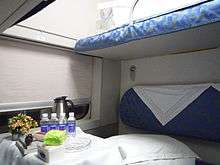
China Railway High-speed runs different electric multiple unit (trainsets), the designs of which all are imported from other nations and given the designations CRH-1 through CRH-5. CRH trainsets are intended to provide fast and convenient travel between cities. Some of the trainsets are manufactured locally through technology transfer, a key requirement for China. The signalling, track and support structures, control software and station design are developed domestically with foreign elements as well, so the system as a whole could be called Chinese. China currently holds many new patents related to the internal components of these train sets since they have re-designed major components so the trains can run at a much higher speed than the original foreign train design.
- CRH1, produced by Bombardier's joint venture Sifang Power (Qingdao) Transportation (BST); CRH1A & CRH1B, nicknamed "Metro" or "Bread", derived from Bombardier Regina; CRH1E, nicknamed "Lizard", is Bombardier's ZEFIRO 250 design.
- CRH2, nicknamed "Hairtail", derived from E2 Series 1000 Shinkansen.
- CRH2A: In 2006, China unveiled (CRH2), a modified version of the Japanese Shinkansen E2-1000 series. An order for 60 8-car sets had been placed in 2004, with the first few built in Japan, the rest produced by Sifang Locomotive and Rolling Stock in China.[204]
- CRH2B: a modified 16-car version of CRH2; maximum operating speed of 250 km/h.
- CRH2C (Stage one): a modified version of CRH2, with a maximum operating speed up to 300 km/h achieved by replacing two intermediate trailer cars with motored cars.
- CRH2C (Stage two): a modified version of CRH2C (Stage one version), with a maximum operating speed up to 350 km/h by replacing motors with more powerful ones.
- CRH2E: a modified 16-car version of CRH2 with sleeping cars.
- CRH3C: nicknamed "Rabbit"; derived from Siemens ICE3 (class 403); 8-car sets; maximum operating speed of 350 km/h.
- CRH5A: nicknamed "Donkey"; derived from Alstom Pendolino ETR600; 8-car sets; maximum operating speed of 250 km/h[205]
- CRH6: Designed by CSR Puzhen and CSR Sifang, to be manufactured by CSR Jiangmen, it is designed to have two versions, one with a top operating speed of 220 km/h, and the other with a top operating speed of 160 km/h, to be used at 200 km/h or 250 km/h Inter-city High Speed Rail lines, planned to enter service in late 2012.
- CRH380A: Maximum operating speed of 380 km/h; Developed by CSR and manufactured by CSR SIfang; entered service in 2010.
- CRH380B: upgraded version of CRH3; maximum operating speed of 380 km/h, manufactured by Tangshan Railway Vehicle & Changchun Railway Vehicles; entered service in 2011.
- CRH380CL: designed and manufactured by Changchun Railway Vehicles; maximum operating speed of 380 km/h; scheduled to enter service in 2012.
- CRH380D: also named Zefiro 380; maximum operating speed of 380 km/h; manufactured by Bombardier Sifang (Qingdao) Transportation Ltd. (BST); planned to enter service in 2012.
CRH1A, B,E, CRH2A, B,E, and CRH5A are designed for a maximum operating speed (MOR) of 200 km/h and can reach up to 250 km/h. CRH3C and CRH2C designs have an MOR of 300 km/h, and can reach up to 350 km/h, with a top testing speed more than 380 km/h. However, issues such as cost of maintenance, comfort, and safety make the maximum design speed of more than 380 km/h impractical and remain limiting factors.
| Equipment type | Top speed in test | Designed speed | Seating capacity | Formation | Power (under 25 kV) |
Enter Service |
|---|---|---|---|---|---|---|
| CRH1A | 278 km/h (173 mph) | 250 | 668 or 611 or 645 | 5M3T | 5,300 kW | 2007 |
| CRH1B | 292 km/h (181 mph) | 250 | 1299 | 10M6T | 11,000 kW | 2009 |
| CRH1E | 250 | 618 or 642 | 10M6T | 11,000 kW | 2009 | |
| CRH2A | 282 km/h (175 mph) | 250 | 610 or 588 | 4M4T | 4,800 kW | 2007 |
| CRH2B | 275 km/h (171 mph) | 250 | 1230 | 8M8T | 9,600 kW | 2008 |
| CRH2C Stage 1 | 394.2 km/h (244.9 mph) | 300 | 610 | 6M2T | 7,200 kW | 2008 |
| CRH2C Stage 2 | 350 | 610 | 6M2T | 8,760 kW | 2010 | |
| CRH2E | 250 | 630 | 8M8T | 9,600 kW | 2008 | |
| CRH3C | 394.3 km/h (245.0 mph) | 350 | 600 or 556 | 4M4T | 8,800 kW | 2008 |
| CRH5A | 250 | 622 or 586 or 570 | 5M3T | 5,500 kW | 2007 | |
| CRH380A | 416.6 km/h (258.9 mph) | 380 | 494 | 6M2T | 9,600 kW | 2010 |
| CRH380AL | 486.1 km/h (302.0 mph) | 380 | 1027 | 14M2T | 20,440 kW | 2010 |
| CRH380B | 380 | unknown | 4M4T | 9,200 kW | 2011 (plan) | |
| CRH380BL | 487.3 km/h (302.8 mph) | 380 | 1004 | 8M8T | 18,400 kW | 2010 |
| CRH380CL | 380 | 8M8T | 19,200 kW | 2012 (plan) | ||
| CRH380D | 380 | 495 | 4M4T | 10,000 kW | 2012 (plan) | |
| CRH380DL | 380 | 1013 | 8M8T | 20,000 kW | Canceled (2012 original plan) | |
| CRH6 | 220 | 586 | 4M4T | unknown | 2011 (plan) |
| Table:CRH trainset orders | |||||||||||||||||||||||||||||||||||||||||||||||||||||||||||||||||||||||||||||||||||||||||||||||||||||||||||||||||||||||||||||||||||||||||||||||||||||||||||||||||||||||||||||||||||||||||||||||||||||||||||||||||||||||||||||||||||||||||||||||||||||||||||||||||||||||||||||||||||||||||||
|---|---|---|---|---|---|---|---|---|---|---|---|---|---|---|---|---|---|---|---|---|---|---|---|---|---|---|---|---|---|---|---|---|---|---|---|---|---|---|---|---|---|---|---|---|---|---|---|---|---|---|---|---|---|---|---|---|---|---|---|---|---|---|---|---|---|---|---|---|---|---|---|---|---|---|---|---|---|---|---|---|---|---|---|---|---|---|---|---|---|---|---|---|---|---|---|---|---|---|---|---|---|---|---|---|---|---|---|---|---|---|---|---|---|---|---|---|---|---|---|---|---|---|---|---|---|---|---|---|---|---|---|---|---|---|---|---|---|---|---|---|---|---|---|---|---|---|---|---|---|---|---|---|---|---|---|---|---|---|---|---|---|---|---|---|---|---|---|---|---|---|---|---|---|---|---|---|---|---|---|---|---|---|---|---|---|---|---|---|---|---|---|---|---|---|---|---|---|---|---|---|---|---|---|---|---|---|---|---|---|---|---|---|---|---|---|---|---|---|---|---|---|---|---|---|---|---|---|---|---|---|---|---|---|---|---|---|---|---|---|---|---|---|---|---|---|---|---|---|---|---|---|---|---|---|---|---|---|---|---|---|---|---|---|---|---|---|---|---|---|---|---|---|---|---|---|---|---|---|---|---|---|---|---|
|
| Table:CRH trainset deliveries | ||||||||||||||||||||||||||||||||||||||||||||||||||||||||||||||||||||||||||||||||||||||||||||||||||||||||||||||||||||||||||||||||||||||||||||||||||||||||||||||||||||||||||||||||||||
|---|---|---|---|---|---|---|---|---|---|---|---|---|---|---|---|---|---|---|---|---|---|---|---|---|---|---|---|---|---|---|---|---|---|---|---|---|---|---|---|---|---|---|---|---|---|---|---|---|---|---|---|---|---|---|---|---|---|---|---|---|---|---|---|---|---|---|---|---|---|---|---|---|---|---|---|---|---|---|---|---|---|---|---|---|---|---|---|---|---|---|---|---|---|---|---|---|---|---|---|---|---|---|---|---|---|---|---|---|---|---|---|---|---|---|---|---|---|---|---|---|---|---|---|---|---|---|---|---|---|---|---|---|---|---|---|---|---|---|---|---|---|---|---|---|---|---|---|---|---|---|---|---|---|---|---|---|---|---|---|---|---|---|---|---|---|---|---|---|---|---|---|---|---|---|---|---|---|---|---|---|
Based on data published by Sinolink Securities,[224][225] some small changes were made according to the most recent news.
|
Track technology
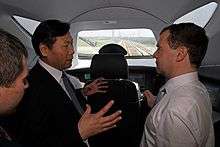
Many of the Passenger Designated Lines use ballastless tracks, which allow for smoother train rides at high speeds and can withstand heavy use without warping. The ballastless track technology, imported from Germany, carries higher upfront costs but can reduce maintenance costs.[226][227]
Typical application of track technology in China high-speed lines
| Type | Classify | Technology | line |
| CRTSIs | slab track | RTRI, Japan | Hada PDL |
| CRTSIIs | slab track | Max Bögl, Germany | Jingjin ICL |
| CRTSIIIs | slab track | CRCC,China | Chengguan PDL |
| CRTSIb | ballastless track | Rail.one, Germany | Wuguang PDL |
| CRTSIIb | ballastless track | Züblin, Germany | Zhengxi PDL |
Technology export
Chinese train-makers and rail builders have signed agreements to build HSRs in Turkey, Venezuela and Argentina[228] and are bidding on HSR projects in the United States, Russia, Saudi Arabia, Brazil (São Paulo to Rio de Janeiro) and Myanmar, and other countries.[35] They are competing directly with the established European and Japanese manufacturers, and sometimes partnering with them. In Saudi Arabia's Haramain High Speed Rail Project, Alstom partnered with China Railway Construction Corp. to win the contract to build phase I of the Mecca to Medina HSR line, and Siemens has joined CSR to bid on phase II.[229] China is also competing with Japan, Germany, South Korea, Spain, France and Italy to bid for California's high-speed rail line project, which would connect San Francisco and Los Angeles.[230] In November 2009, the MOR signed preliminary agreements with the state's high-speed rail authority and General Electric (GE) under which China would license technology, provide financing and furnish up to 20 percent of the parts with the remaining sourced from American suppliers, and final assembly of the rolling stock in the United States.[231]
In January 2014, the China Railway Construction Corporation completed a 30-km section of the Ankara-Istanbul high-speed railway between Eskişehir and İnönü in western Turkey.[232]
In mid 2015, China has signed up to design a high-speed railway between the Russian cities of Moscow and Kazan, one of the first concrete examples of the new business with China that Russian officials have been pursuing with renewed vigor since falling out with the West. A unit of Russia’s state-owned JSC Russian Railways signed a contract Thursday with the design unit of China’s state-controlled China Railway Group to come up with the plans for a 770 kilometer high-speed rail between the two Russian cities. The Chinese firm will work alongside two Russian companies for on the designs for a total cost of 20.8 billion rubles ($383 million) over the next two years, according to Russian Railways.
Once the designs are developed, a separate tender will be held for the actual construction of the rail link, which Russian Railways expects to cost 1.06 trillion rubles ($19.5 billion).[233]
Maglev high-speed rail
China has the world's only commercial maglev high-speed train line in operation: The Shanghai Maglev Train, a turnkey Transrapid maglev demonstration line 30.5 km long. The trains have a top operational speed of 430 km/h and can reach a top non-commercial speed of 501 km/h. It opened for operations in March 2004, and transports passengers between Shanghai's Longyang Road Metro Station and Shanghai Pudong International Airport. There have been numerous attempts to extend the line without success. A Shanghai-Hangzhou maglev line was also initially discussed but later shelved in favour of conventional high-speed rail.[234]
Two other Maglev lines, the Changsha Maglev and the Line S1 of Beijing, were designed for commercial operations with speeds lower than 120 km/h.[235]
Records
Fastest trains in China

The "fastest" train commercial service can be defined alternatively by a train's top speed or average trip speed.
- The fastest train service measured by peak operational speed is the Shanghai Maglev Train which can reach 431 km/h (268 mph). Due to the limited length of the Shanghai Maglev track (30 km)(18.6 mi), the maglev train's average trip speed is only 245.5 km/h (152.5 mph).
- The fastest train service measured by average trip speed from 2009 until 2011 was on the Wuhan-Guangzhou High-Speed Railway, where from December 2009 until July 1, 2011, the CRH3/CRH2 coupled-train sets averaged 312.5 km/h (194.2 mph) on the 922 km (573 mi) route from Wuhan to Guangzhou North. However, on July 1, 2011 in order to save energy and reduce operating costs, the maximum speed of Chinese high-speed trains was reduced to 300 km/h, and the average speed of the fastest trains on the Wuhan-Guangzhou High-Speed Railway was reduced to 272.68 km/h (169 mph).
- The top speed attained by a non-maglev train in China is 487.3 km/h (302.8 mph) by a CRH380BL train on the Beijing–Shanghai High-Speed Railway during a testing run on January 10, 2011.[236]
Longest service distance
The G529/530 Beijing West (Beijingxi)-Beihai train (2697 km, 15 1/2 hours for southbound train, 15 3/4 hours for northbound train), which began service on December 28, 2013 and extended on July 1, 2016, became the longest high-speed rail service in the world.[237] It overtook the G1276/7/G1278/5 Harbin West (Harbinxi)-Wuhan train (2446 km, 14 1/2 hours), which had set the previous record on December 10, 2014.[238]
See also
- China Railway High-speed
- Fastest trains in China
- High-speed rail by country
- Rail transport in China
-
 Media related to China Railway High-speed at Wikimedia Commons
Media related to China Railway High-speed at Wikimedia Commons -
 High-speed rail in China travel guide from Wikivoyage
High-speed rail in China travel guide from Wikivoyage
Notes
- ↑ According to Xinhua News Agency, the aggregate results of the six “Speed Up Campaigns” were: boosting passenger train speed on 22,000 km (14,000 mi) of tracks to 120 km/h (75 mph), on 14,000 km (8,700 mi) of tracks to 160 km/h (99 mph), on 2,876 km (1,787 mi) of tracks to 200 km/h (124 mph) and on 846 km (526 mi) of tracks to 250 km/h (155 mph).[13] According to China Daily, however, there were 6,003 km (3,730 mi) of tracks capable of 200 km/h (124 mph) in April 2007.[14]
References
- ↑ 2016-05-28 (2016-05-28). "中国高速铁路_百度百科". Baike.baidu.com. Retrieved 2016-06-03.
- ↑ "High-speed rail a vital social good" Global Times 2014-12-15
- 1 2 "Chinese high speed network to double in latest master plan". Railway Gazette.
- ↑ "China Exclusive: Five bln trips made on China's bullet trains - Xinhua | English.news.cn". news.xinhuanet.com. Retrieved 2016-08-08.
- ↑ "World's Longest Fast Train Line Opens in China". Associated Press. Retrieved 26 December 2012.
- 1 2 3 "China acts on high-speed rail safety fears". Financial Times. 2011-04-14. Retrieved 2011-08-17.
- 1 2 Louise Young. Japan's Total Empire. Berkeley: University of California Press 1998. pp.246-7.
- 1 2 3 (Chinese) "京沪高速铁路的论证历程大事记" Accessed 2010-10-04
- ↑ (Chinese) 高铁时代 中国国家地理网 2010-04-07
- ↑ By the mid-1990s, average train speed in China was about 60 km/h (37 mph). (Chinese) "China plans five-year leap forward of railway development " Accessed 2006-09-30
- ↑ (Chinese) "中国铁道部六次大提速" Sina News Center Accessed 2010-10-04
- ↑ "(Chinese)". News.cctv.com. Retrieved 2011-08-14.
- ↑ 中国高铁"十一五"发展纪实:驶向未来 (in Chinese). Xinhua News Agency. 2010-09-25. Retrieved 2015-05-09.
- ↑ Dingding, Xin (2007-04-18). "Bullet trains set to join fastest in the world". China Daily. Retrieved 2015-05-09 – via HighBeam Research. (subscription required (help)).
- 1 2 International Railway Journal – Rail And Rapid Transit Industry News Worldwide Archived August 15, 2007, at the Wayback Machine.
- ↑ (Chinese) Accessed 2010-10-13
- ↑ "Hundreds protest Shanghai maglev rail extension". Reuters. Jan 12, 2008.
- ↑ "Rail track beats Maglev in Beijing–Shanghai High Speed Railway". People's Daily. 2004-01-18. Retrieved 2011-10-17.
- ↑ "Beijing–Shanghai High-Speed Line, China". Railway-technology.com. 2011-06-15. Retrieved 2011-10-17.
- 1 2 3 4 5 6 (Chinese) "中国式高铁的诞生与成长" Xinhua March 4, 2010
- ↑ (Chinese) "日本等待中国'求婚'" 2003-08-06
- ↑ "Violence flares as the Chinese rage at Japan" Guardian 2005-04-17
- ↑ "High speed Train CRH1 – China" Bombardier Accessed 2010-08-14
- ↑ "Kawasaki Wins High-Speed Train Order for China" 2004–10 Archived June 8, 2008, at the Wayback Machine.
- ↑ "How Japan Profits From China's Plans" Forbes 2009-10-26
- ↑ (Chinese) "CRH5型动车组详细资料" 中国铁路网 2009-11-18
- ↑ "庞巴迪:靠什么"赢在中国"——专访庞巴迪中国区总裁兼首席代表张剑炜". Worldrailway.com.cn. Retrieved 2011-08-17.
- ↑ "Japan Inc Shoots Itself on the Foot". Financial Times. 2010-07-08. Retrieved 2011-08-14.
- ↑ "Era of "Created in China"". Chinapictorial.com.cn. Retrieved 2011-08-14.
- ↑ "China: A future on track". Xinkaishi.typepad.com. 2010-10-05. Retrieved 2011-08-14.
- ↑ 汪玮 (2011-07-08). "China denies Japan's rail patent-infringement claims. On 2011-07-24. Retrieved 2011-07-25". China.org.cn. Retrieved 2011-08-14.
- ↑ "First Chinese designed HS train breaks cover:". International Railway Journal. September 2010.
- ↑ "China's 'Super-Speed' Train Hits 500km". 2010-10-20.
- 1 2 3 4 Bradsher, Keith (2010-02-12). "Keith Bradsher, "China Sees Growth Engine in a Web of Fast Trains"". China; United States: Nytimes.com. Retrieved 2011-08-17.
- 1 2 3 "China to Bid on US High-Speed Rail Projects" A.P. March 13, 2010 Archived March 17, 2010, at the Wayback Machine.
- 1 2 3 Forsythe, Michael (2009-12-22). "Michael Forsythe "Letter from China: Is China's Economy Speeding Off the Rails?"". China: Nytimes.com. Retrieved 2011-08-17.
- 1 2 "China's fastest high speed train 380A rolls off production line" Xinhua 2010-05-27
- ↑ "时速380公里高速列车明年7月开行 " 2010-11-02
- ↑ xinhuanet (2011-02-04). "High-speed rail broadens range of options for China's New Year travel". Retrieved 2011-02-04.
- ↑ http://www.uic-highspeed2010.com.cn/upload/ChineseRailways20101011.pdf
- ↑ "2011年中国铁路将投资7000亿元_公司频道_财新网". Business.caing.com. 2011-01-05. Retrieved 2011-10-17.
- 1 2 3 "Off the rails?". The Economist. 2011-03-31.
- ↑ "China finds 187 mln yuan embezzled from Beijing-Shanghai railway project". News.xinhuanet.com. 2011-03-23. Retrieved 2011-08-14.
- ↑ Moore, Malcolm (2011-08-01). "Chinese rail crash scandal: 'official steals $2.8 billion'". The Telegraph. Retrieved 2012-04-27.
- 1 2 "China Puts Brakes on High-Speed Trains" The Wall Street Journal 2011-04-17
- ↑ "China slows down showcase bullet trains" Bloomberg Businessweek 2011-04-17
- ↑ "World's longest high-speed train to decelerate a bit". People's Daily Online. 2011-04-15.
- ↑ "The Backlash Is Brewing Against Chinese High-Speed Rail: Here's Why It's In Trouble" Business Insider 2011-04-17
- ↑ "Beijing-Shanghai high-speed railway to run trials". News.xinhuanet.com. 2011-05-11. Retrieved 2011-08-14.
- ↑ (Chinese) "叫停津秦高铁跟刘志军落马无关" 齐鲁晚报 May 27, 2011
- ↑ (Chinese) "环保部叫停津秦铁路、胶济铁路两高铁建设运行" 新京报 2011-05-19
- ↑ (Chinese) Yan Weijue, "China not slowing high-speed rail construction" Chinadaily.com.cn June 7, 2011
- ↑ "时速380公里高速列车明年7月开行" 2010-11-02
- ↑ "京沪高铁2010年审计未发现重大质量问题".
- ↑ "Train speed claims were false".
- ↑ "Railway cuts bullet trains from schedule | Sunday Digest". China Daily. 2011-07-23. Retrieved 2011-08-14.
- ↑ Johnson, Ian (2011-07-24). "Train Wreck in China Heightens Unease on Safety Standards". The New York Times.
- 1 2 Watt, Louise (2011-07-25). "Crash raises doubts about China's fast rail plans". Washington Times. Retrieved 2011-10-17.
- ↑ Tania Branigan in Beijing and agencies (2011-08-12). "Chinese bullet trains recalled in wake of fatal crash | World news". The Guardian. UK. Retrieved 2011-10-17.
- ↑ Lafraniere, Sharon (2011-07-28). "Five Days Later, Chinese Concede Design Flaw Had Role in Wreck". The New York Times.
- ↑ Reinoso, Jose (2011-07-29). "Un error en las señales causó el choque de trenes chinos". El País Archivo (in Spanish). Retrieved 2015-10-17.
- ↑ "La signalisation mise en cause dans l'accident du Pékin-Shanghaď". Le Monde (in French). France. Retrieved 2011-10-17.
- ↑ "La sécurité des TGV chinois de plus en plus contestée". Le Monde (in French). France. Retrieved 2011-10-17.
- ↑ 'First Fatal Crash on Chinese High Speed Line,' Railway Gazette International, 25 July 201 http://www.railwaygazette.com/nc/news/single-view/view/first-fatal-crash-on-chinese-high-speed-line.html
- ↑ Martin Patience (2011-07-28). "BBC News - China train crash: Signal design flaw blamed". Bbc.co.uk. Retrieved 2011-08-17.
- ↑ Cherry Wilson (2011-07-23). "China train crash kills 32 The Observer". Guardian. UK. Retrieved 2011-08-14.
- ↑ Martin Patience (2011-07-28). "China train crash: Signal design flaw blamed". BBC. Retrieved 2011-08-14.
- ↑ Coonan, Clifford (2011-08-12). "Outrage at Wenzhou disaster pushes China to suspend bullet train project". London: The Independent. Retrieved 2011-08-17.
- ↑ "China's High-Speed Rail Accident 'Struck a Nerve' | The Rundown News Blog | PBS NewsHour". PBS. 2011-08-10. Retrieved 2011-08-17.
- ↑ Pilling, David (2011-08-03). "China crashes into a middle class revolt". FT.com. Retrieved 2011-08-17.
- ↑ Reuters in Beijing (2011-08-10). "China steps up train safety amid anger after crash | World news | guardian.co.uk". The Guardian. UK. Retrieved 2011-10-17.
- ↑ "China freezes new railway projects after high-speed train crash". Reuters. 2011-08-10. Retrieved 2011-10-17.
- ↑ "China train crash: Design flaws to blame - safety chief". BBC. 2011-08-12. Retrieved 2011-08-17.
- ↑ Rabinovitch, Simon (2011-08-11). "China suspends new high speed rail plans". FT.com. Retrieved 2011-08-17.
- ↑ "China freezes new railway projects after high-speed train crash". Reuters. 2011-08-10. Retrieved 2011-08-17.
- ↑ 'Decision to slow trains met with mixed response,'http://www.chinadaily.com.cn/cndy/2011-08/12/content_13097239.htm
- ↑ 'More high speed trains slow down to improve safety,'http://www.chinadaily.com.cn/china/2011-08/23/content_13167866.htm
- ↑ "CapitalVue News: China Cuts Ticket Price Of High Speed Rail". Capitalvue.com. 2011-08-12. Retrieved 2011-08-17.
- 1 2 3 4 Rabinovitch, Simon (2011-10-27). "China's high-speed rail plans falter". China: Financial Times. Retrieved 2011-10-27.
- 1 2 "China's high speed rail projects on hold due to cash crunch". Economic Times. 2011-10-27. Retrieved 2011-10-27.
- 1 2 3 (Chinese) "中国铁路建设大规模停工 建设重点出现调整" 2011-10-26
- ↑ (Chinese) "铁道部负债近2万亿 净资产收益率偏低" infzm.com 2011-07-19
- 1 2 3 4 (Chinese) "铁路建设9成缺钱停工 多地高铁项目拖欠工人工资停工" 中国经营网 2011-10-26
- ↑ (Chinese) "铁路工地一线直击:2700亿掀不起复工潮" 2011-12-14
- ↑ 市发改委:渝西高铁搁浅. 重庆到西安将借道西成高铁, Chongqing Ribao, 2012-09-28
- 1 2 (Chinese) "揭秘:贵广高铁如何穿越喀斯特" 南方都市报 2014-12-26
- ↑ (Chinese) 陈清浩, "贵广高铁正式开通运营 从贵阳到广州4小时可达" 南方日报 2014-12-26
- 1 2 3 Simon Rabinovitch, “China’s high-speed rail gets back on track” ‘’Financial Times’’ 2013-01-16
- 1 2 3 "铁路2014年投资8088亿元 超额完成全年计划". 人民网. 2015-01-30. Retrieved 2015-01-30.
- ↑ Fischer, Elizabeth (2012-11-21). "China's high-speed rail revolution". Railway-technology.com. Retrieved 2013-05-04.
- ↑ Shasha, Deng (2012-12-26). "World's longest high-speed rail line makes debut". Xinhua. Retrieved 2013-05-04.
- ↑ "China High Speed Train Development and Investment". The China Perspective. 2012-12-27. Retrieved 2015-10-17.
- 1 2 "Sound financials recharge China's fast trains". marketwatch.com. 2012-09-10. Retrieved 2013-02-03.
- 1 2 3 "Bullet trains trigger profit growth for railways". The Irish Times. 2012-09-25. Retrieved 2013-02-03.
- 1 2 "China's high-speed rail still reporting staggering losses". chinawatch.com. 2013-02-03. Retrieved 2013-02-03.
- ↑ "China's railways mileage tops 100,000 km" Xinhua 2013-12-28
- ↑ (Chinese)[中国高铁版图再扩容:兰新、贵广、南广高铁今日开通 中国新闻网 2014-12-26
- 1 2 (Chinese) "青荣城际今日通车 青烟威三城连心" 青岛新闻网 2014-12-28
- 1 2 (Chinese) 12月10日起铁路再调图 Xinhua 2014-11-15
- ↑ (Chinese) 7月1日全国铁路再调图 增开动车组列车53对 人民日报 2014-06-12
- 1 2 3 4 (Chinese) 发改委再批复两城市铁路规划 总投资超2000亿 中证网 2014-12-22
- ↑ (Chinese) 郑州-重庆万州高铁获批 中部再添开发主轴 2014-10-10
- ↑ (Chinese) 临沂至曲阜客运专线并轨京沪高铁获批 连云港至镇江高铁获批 预计2019年下半年通车 2014-11-07
- ↑ (Chinese) 临沂至曲阜客运专线并轨京沪高铁获批 2014-12-16
- ↑ (Chinese) 哈牡客运专线项目启动建设 打通亚欧国际货运大通道 2014-12-18
- ↑ (Chinese) 浙江11条城际铁路线昨日获批 2020年前将全部建成 2014-12-18
- ↑ "Chinese Trainmakers To Merge And Form Export Powerhouse" AFP 2014-12-03
- ↑ "中国高铁盈利地图:东部线路赚翻 中西部巨亏(图)-新华网". news.xinhuanet.com. Retrieved 2016-08-08.
- ↑ Staff, WSJ. "China's Busiest High-Speed Rail Line Makes a Fast Buck". Retrieved 2016-08-08.
- ↑ http://dailynews.sina.com/bg/chn/chnmilitary/sinacn/20160720/16407430511.html
- ↑ "十年内高铁运营里程将翻倍 贯通特大城市可采用时速350公里标准 | 每经网". www.nbd.com.cn. Retrieved 2016-10-13.
- ↑ "China develops bullet train with fold-up beds". China Daily. Xinhua. 14 November 2016. Retrieved 15 November 2016.
- 1 2 3 4 Freeman, Will (2010-06-02). "Freeman & Kroeber, "Opinion: China's Fast Track to Development"". Wall Street Journal. Retrieved 2011-08-17.
- 1 2 Bradsher, Keith (2009-01-22). "Keith Bradsher, "China's Route Forward"". China: Nytimes.com. Retrieved 2011-08-17.
- 1 2 3 4 China's amazing new bullet train CNN Money August 6, 2009
- ↑ "China's high-speed-rail network and the development of second-tier cities". JournalistsResource.org, retrieved Feb. 20, 2014.
- ↑ "Japan Inc shoots itself in foot on bullet train". Ft.com. 2010-07-08. Retrieved 2011-08-17.
- 1 2 3 4 5 6 7 (Chinese) "铁道部有意打包高铁资产 成立资产管理公司" 中财网 2010-09-25 Archived July 7, 2011, at the Wayback Machine.
- ↑ Shelley Smith "Yuan Bond Sales Climb to Record Led by Railways: China Credit" Bloomberg 2010-10-13
- ↑ 我国首条快速客运专线"秦沈客运专线"开通. news.sina.com.cn (in Chinese). 2003-10-12.
- ↑ 合宁铁路今天通车运营. ah.people.com.cn (in Chinese). 2008-04-18.
- ↑ "胶济铁路客运专线施工进入决战阶段".
- ↑ "石太铁路客运专线".
- ↑ "合武铁路昨建成通车".
- ↑ "甬台温铁路客运专线8月1日开通".
- ↑ "温福铁路温州段明天通货运 温州将迎来高铁时代".
- ↑ "福厦高铁正式开通运营 打造绿色环保"快车道"".
- ↑ "成灌快铁开通四川迈入快铁时代".
- ↑ "昌九城际高铁今日开通 江西迈入高铁时代".
- ↑ "东北首条城际高速铁路开通 总投资达96亿(组图)".
- ↑ "东环铁今开通 本报今推《东环铁乘车指南》".
- ↑ "京津城际铁路通车新闻发布会".
- ↑ "武广快线驶出中国新速度".
- ↑ "郑西高速铁路昨成功试运行".
- ↑ "沪宁城际高铁通车 沪宁对开客运列车每日近百对".
- ↑ "沪杭高铁简介及线路站点图示".
- ↑ "京沪高铁开通首日上座率达98%".
- 1 2 3 4 5 6 7 (Chinese) "不计建设投资 京津高铁今年持平" 经济观察报 2010-09-18
- ↑ (Chinese) "京津城际高铁二线拟明年开工 或通过三河、香河、大厂" 2014-12-20
- 1 2 3 4 (Chinese) "4万公里快速铁路网冲刺" 21世纪经济报道 2010-09-30
- ↑ (Chinese) 火爆城际铁路的上座率考验 第一财经日报 2014-12-24
- ↑ (Chinese) 河南对城际铁路实行运营亏损补贴 补亏期暂定5年 河南日报 2014-12-11
- 1 2 Bradsher, Keith (2013-09-24). "Speedy Trains Transform China". New York Times. Retrieved 2013-09-26.
- ↑ "去哪儿网 北京济南火车票" March 27, 2013
- ↑ "Why Acela" March 27, 2013
- ↑ "Is Low-Cost Intercity Rail Possible? | Pedestrian Observations". Pedestrianobservations.wordpress.com. Retrieved 2016-06-03.
- 1 2 3 4 (Chinese) "高铁分流民航客源:多条短程航班停飞" infzm.com 2011-04-06
- ↑ "China ready to roll out 35 high-speed rail lines by 2012". Sify.com. 2009-06-24. Retrieved 2011-08-14.
- ↑ China starts work on Beijing-Shanghai express railway Xinhua 2008-04-18
- ↑ "Passenger Dedicated Lines will spearhead CR's inter-city speed-up". Railway Gazette International. 2007-08-22.
- 1 2 "30,000-kilometer high-speed railway to cover 80% of urban areas by 2020". People's Daily Online. July 21, 2016.
- ↑ MacLeod, Calum (June 1, 2011). "China slows its runaway high-speed rail expansion". USA Today. Retrieved 2011-08-14.
- ↑ (Chinese) 2010-10-16
- ↑ "中国高速铁路: 运量分析" (PDF) (in Chinese). World Bank. December 2014. Archived from the original (PDF) on 2014-12-21. Retrieved 2015-10-17.
- ↑ "铁路2014年投资8088亿元 超额完成全年计划-财经-人民网". 人民网 - people.com.cn (in Chinese). 2015-01-30. Retrieved 2015-10-17.
- ↑ http://news.xinhuanet.com/english/2016-07/21/c_135530835.htm
- ↑ (Chinese) 2010-09-25
- 1 2 123查/中国火车时刻表在线查询 (in Chinese).
- ↑ "Train No.D7027 timetable".
- ↑ "Train No.D382 timetable".
- ↑ "Train No.D135 timetable".
- ↑ "Train No.D25 timetable".
- ↑ "Train No.D37 timetable".
- ↑ "Train No.D5117 timetable".
- ↑ "Train No.D307 timetable".
- ↑ "Train No.D13248-3245 timetable".
- ↑ "Train No.D131 timetable".
- ↑ "铁路客户服务中心". 12306.cn. Retrieved 2011-08-17.
- ↑ "Train No.G1001 timetable".
- ↑ 京广高速铁路武广段开通运行. society.people.com.cn (in Chinese). 2009-12-26.
- ↑ "Train No.G7301 timetable".
- 1 2 "沪宁沪杭增开4.5对动车".
- ↑ 沪杭高铁引领世界. www.chnrailway.com (in Chinese).
- ↑ "Train No.G7102 timetable".
- ↑ "提示信息 铁路在线论坛". Bbs.ourail.com. Retrieved 2015-10-17.
- ↑ "国庆长假进入尾声 南京铁路往南通徐州增1趟临客 – 中国徐州网". Cnxz.com.cn. 2010-10-06. Retrieved 2011-08-14.
- ↑ "Train No.C2001 timetable".
- ↑ "京津城际加车五一每天百对".
- ↑ 京津城际动车组列车将统一车型 (in Chinese).
- ↑ "Train No.G2024 timetable".
- ↑ "郑西客运专线春运试运营 西安到郑州仅2小时(图)-郑西客专-旅游". Travel.hsw.cn. 2010-01-18. Retrieved 2011-08-14.
- ↑ "Train No.D3107 timetable".
- ↑ 71调图甬台温所有交路车型情况 (in Chinese). 2010-06-23.
- ↑ "Train No.D3108 timetable".
- 1 2 "426调图后,沿海动车(浙江段)相关车次套跑情况 – 铁路宁波站 – Ningbo Railway Station – 宁波城建论坛 – Powered by Discuz!". Bbs.nbuc.net. Retrieved 2011-08-14.
- ↑ "Train No.D2015 timetable".
- ↑ "石太客运专线正式通车 全程省时近4小时(图)_国内图片_新闻_腾讯网". News.qq.com. Retrieved 2011-08-14.
- ↑ "Train No.D3201 timetable".
- ↑ "Train No.D6342 timetable".
- ↑ "昌九城际铁路动车组车型揭晓(组图)_新闻中心_新浪网". News.sina.com.cn. Retrieved 2011-08-14.
- ↑ "Train No.D3052-D3053 timetable".
- 1 2 Archived July 15, 2011, at the Wayback Machine.
- ↑ "Train No.D6002 timetable".
- ↑ "曾经胶济线上的CRH2们 – 我的铁路影集 – 长江铁路网论坛|和谐号|CRH|HXD – Powered by Discuz!". Railwayfan.net. Retrieved 2011-08-14.
- ↑ "Train No.D3054-D3051 timetable".
- ↑ "Train No.D6111 timetable".
- ↑ "成都铁路局最新CRH动车组详细配属情况" (in Chinese). 2010-07-17.
- ↑ "Train No.D5055 timetable".
- ↑ "Train No.D7303 timetable".
- ↑ "Train No.D7613 timetable".
- ↑ "Train No.D7709 timetable".
- ↑ Shanghai Hongqiao Schedule(Chinese)
- 1 2 南京到西安可以乘动车了 去哈尔滨也有始发站列车 (One will be able to ride an EMU from Nanjing to Xi'an. There also will be a [Nanjing-originated] service to Harbin) 2012-12-14 (Chinese) (The planned Nanjing-Harbin service mentioned in the article will be "conventional", not high-speed)
- ↑ "High speed trainsets take shape". Railway Gazette International. 2005-08-01.
- ↑ "China's high speed fleet expands steadily". Railway Gazette International. 2007-08-01.
- ↑ 法中企业握手互利共赢. news.xinhuanet.com (in Chinese). 2004-10-25.
- ↑ "2004年10月12日,BSP与铁道部及广州铁路(集团)签订了20列(160辆)EMU动车组". www.bsp.cn (in Chinese). 2006-01-12.
- 1 2 3 4 "CRH2型动车组详细资料及分类". news.chineserailways.com (in Chinese). 2009-12-14.
- ↑ 庞巴迪:又获铁道部动车组大订单. info.traffic.hc360.com (in Chinese). 2005-06-10.
- ↑ 西门子专家进驻唐山机车车辆厂. hebei.moform.gov.cn (in Chinese). 2006-08-15.
- ↑ "BSP公司在北京签订40列EMU动车组订单". www.bsp.cn (in Chinese). 2007-11-02.
- ↑ 招商证券-中国南车-601766-动车交付高峰来临,业绩逐季增... www.docin.com (in Chinese).
- ↑ "公司与北京铁路局签订了30列CRH5型动车组采购合同". www.cccar.com.cnom (in Chinese).
- ↑ 唐车公司拿到京沪高铁动车组大订单 总金额392亿. info.china.alibaba.com (in Chinese). 2009-03-17.
- 1 2 中国南车:中标巨额合同 增厚公司业绩. www.guosen.com.cn (in Chinese). 2009-09-30.
- ↑ "Zefiro 250NG included in revised high speed train contract". Railway Gazette. 2012-09-05. Retrieved 2015-10-17.
- ↑ 长客签下235亿订单. jlrbszb.chinajilin.com.cn (in Chinese). 2009-09-28.
- ↑ 招商证券-中国北车-601299-动车组第三批高毛利率订单将陆续交付. www.docin.com (in Chinese).
- ↑ "关于CRH3和380B的提问". bbs.ourail.com (in Chinese).
- ↑ 中国南车获国内首个城际列车项目订单 总值23.46亿人民币 (in Chinese).
- ↑ "Bombardier Sifang Awarded Fourth Contract for 40 Additional CRH1 High-Speed Trains in China". cn.bombardier.com. 2010-07-16.
- ↑ 中国南车:再中标动车组订单、未来高增长确定::全景证券频道. www.p5w.net (in Chinese). 2010-09-30.
- ↑ "http://news.xinmin.cn/rollnews/2010/10/13/7194620.html". news.xinmin.cn (in Chinese). 2010-10-13. External link in
|title=(help) - ↑ 中国南车研究报告:国金证券-中国南车-601766-通往春天的铁路设备龙头. www.docin.com (in Chinese).
- ↑ 国金证券-中国北车-601299-动车交付单价已触底,毛利率回升可期. www.docin.com (in Chinese).
- ↑ "GC Ticker June–July 2009" (PDF). Google. Retrieved 2011-08-14.
- ↑ "WuGuang High Speed Rail Project". Docstoc.com. 2010-02-05. Retrieved 2011-08-14.
- ↑ Keith Bradsher (2010-04-08). "China Is Eager to Bring High-Speed Rail Expertise to the U.S.". The New York Times. Retrieved 2010-04-08.
- ↑ "Siemens joins China bid for Saudi Haramain project" March 24, 2010
- ↑ "China Is Eager to Bring High-Speed Rail Expertise to the U.S." N.Y. Times 2010-04-10
- ↑ "GE and China MOR Sign Strategic MOU to Advance High-Speed Rail Opportunities in the U.S.". 3blmedia.com. 2009-11-17. Retrieved 2011-08-17.
- ↑ Chinese Firm Constructs High-Speed Railway in Turkey 2014-01-18
- ↑ Sonne, Paul (2015-06-19). "China to Design New Russian High-Speed Railway". WSJ. Retrieved 2016-06-03.
- ↑ "No timetable yet for Shanghai-Hangzhou maglev line: official". Xinhua News Agency. 2010-03-23. Archived from the original on 2010-03-23. Retrieved 2010-03-23.
- ↑ "Beijing's first maglev line resumes construction". China Daily. April 22, 2015.
- ↑ "中国北车刷新高铁运营试验世界纪录速度(图)-搜狐证券". Stock.sohu.com. Retrieved 2011-08-14.
- ↑ (Chinese) "北京西至北海将开通全国运行里程最长动车" 中国青年报 2016-06-15
- ↑ (Chinese) "哈尔滨至武汉高铁今日开通 创世界最长高铁记录" 中新网 2014-12-10
